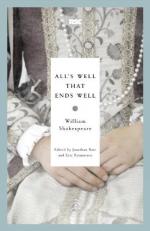|
This section contains 11,198 words (approx. 38 pages at 300 words per page) |

|
SOURCE: “Helena's Bed-trick: Gender and Performance in All's Well That Ends Well,” in Shakespeare Quarterly, Vol. 45, No. 4, Winter, 1994, pp. 449-68.
In the following essay, McCandless analyzes All's Well That Ends Well's concern with sexuality, and the importance of Helena's bed-trick to “the play's provocative interrogation of gender roles.”
The starting point for this essay is Susan Snyder's recent characterization of All's Well as a “deconstructed fairy tale”:1 lurking beneath the folkloric narrative of the poor physician's daughter who deploys magic and cunning in order to overcome a dashing count's disdainful resistance are the unrepresentable specters of female sexual desire and male sexual dread. Indeed, the play invests the fairy-tale motifs that W. W. Lawrence believes undergird All's Well—“The Healing of the King” and “The Fulfillment of the Tasks”—with potent erotic subtexts.2 In adapting “The Healing of the King,” Shakespeare, like his model Boccaccio, departs from...
|
This section contains 11,198 words (approx. 38 pages at 300 words per page) |

|


